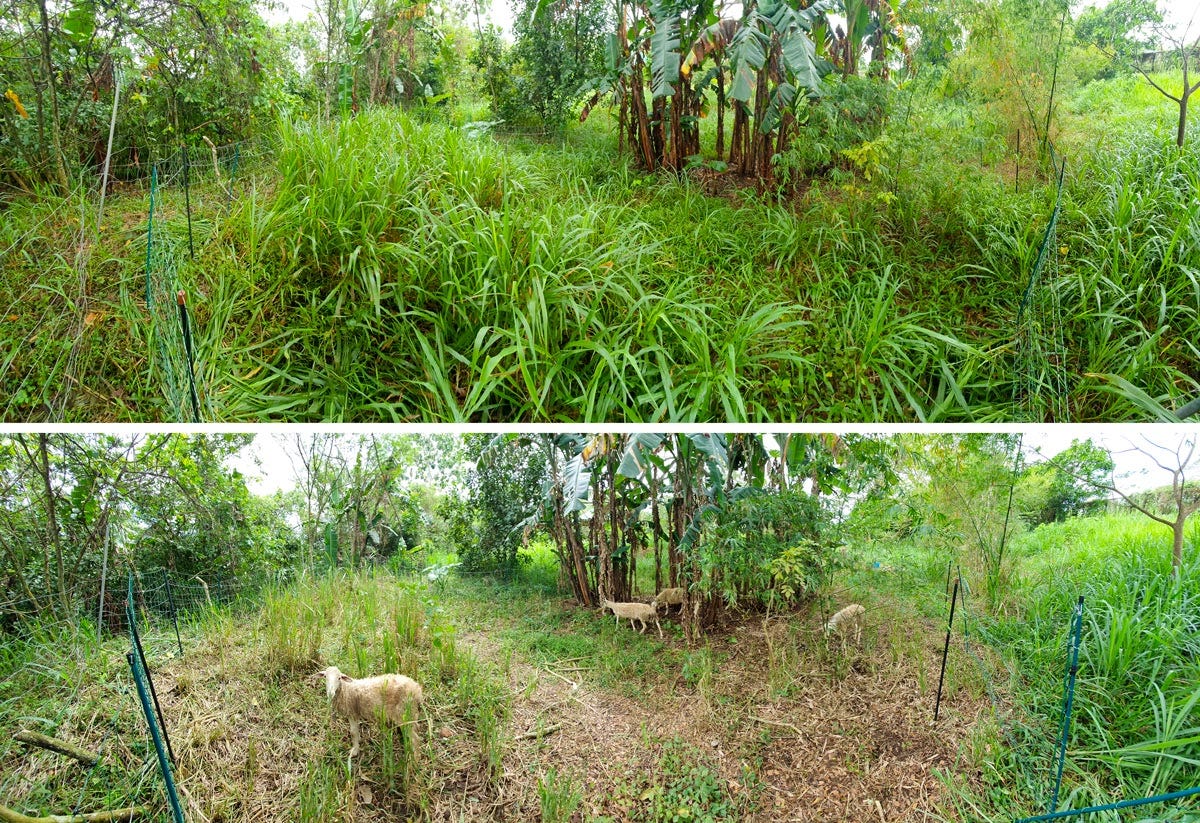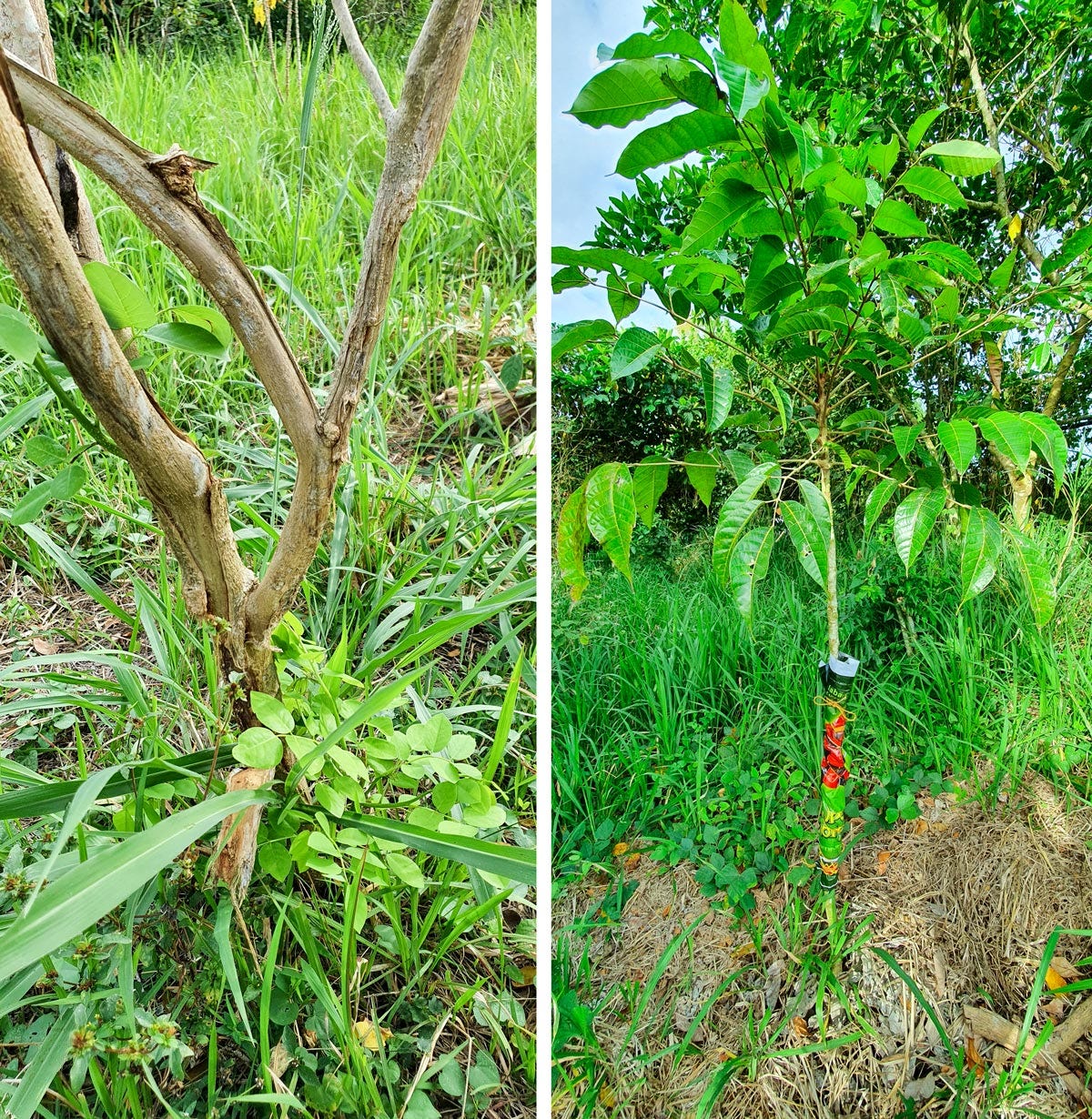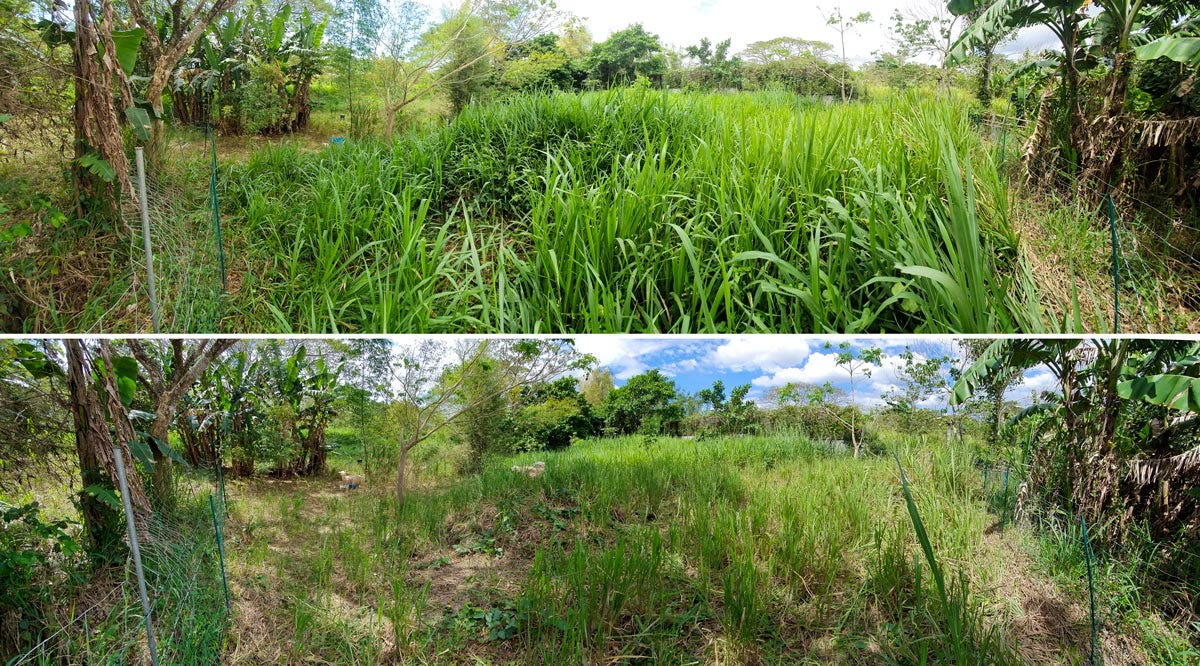Our Animal Management: Sheep
March 2022. My dreams of having a small herd of sheep have since been dashed but this is how we were managing them at the time. I might do it differently if given another opportunity.
We recently added 4 sheep to the farm. Despite growing up on a sheep farm I'm very inexperienced with raising them myself and this is just our short experience with them so far. I'm very open to suggestions!
On good advice we delayed the introduction of any larger livestock. Firstly, we wanted to be sure I could feed them throughout the dry summer, which has been a fairly short 3-4 month period since we’ve been here. Secondly, we wanted to be sure it wouldn’t overwhelm us with the amount of time needed to manage them.
The four sheep, Nige (young ram) and his ladies Edna, Kylie and Betty are St. Croix sheep. We chose these for a couple of reasons:
A breed that’s well adapted to the heat and humidity of the tropics.
Sheds it’s wool/hair.
Known for parasitic resistance
Small
We already spend quite a bit of time feeding and looking after animals so it was important to get an animal that we could spend minimal time on. We check their water every day and make sure they’re looking happy, and we move them about every 4-6 days, that’s it. Not having to shear them was a bonus. Although wool is a valuable resource, we would struggle to make the time to process it and would need to import tools to do so.
We wanted a breed that we wouldn’t need to vaccinate for worms and this was primarily for soil health. Some animal de-worming products such as Ivermectin not only kill the intestinal worms, but will continue in its potency when shat out by the sheep. Since we are rotating the sheep around the property as a natural fertiliser, it’s no good to us if the sheep poo kills any of the soil microbial life and bugs such as dung beetles that are actively trying to break it down.
So far, I've seen very little, slow decomposition activity in the breaking down of old poop, this could be that my soil microbial life is still poor and that we don't have the numbers of dung beetles needed, or it could be that the sheep were vaccinated before we purchased them.
I believe that by rotating the animals around the property and eventually integrating chickens into the mix in order to break the parasite load, we can reduce the potential for worms. From what I understand, it's rarely the worms that will kill the sheep, rather it's an additional stressor that can weaken a sheep when other stresses occur such as inclement weather.
Since we will be butchering these sheep ourselves we wanted an animal small enough to confidently handle. Sadly I’ve already had to butcher one of the sheep (Kylie, probably due to bloat) and it was a fairly easy and quick job because she was so small.
We use electric fencing that we imported from the USA, “Premier One” brand; so far so good and no complaints. I connect two sections of fence together for a total perimeter of 60m. Having a spare set of fences makes the move much easier, since you can set up the new paddock next to the old one and simply let the sheep through. I scythe the grass where the fencing perimeter will go first to reduce the grass grounding out the netting.

I now keep a very close eye on the sheep for the first few days after a move to make sure they're not suffering from bloat or any toxicity. So far, I only know that lantana is possibly toxic to the sheep so I remove it if I spot any. Too much fresh legumes can cause bloat and so I make sure they don’t have too many leguminous vines in the area.
If there's any important trees in their new area I wrap an old sack around its trunk so that they cannot ringbark it. The great thing about an agroforestry system like ours is that there is shade and shelter everywhere because of all the trees. I don't worry so much about the Kakawate (Madre de Cacao / Gliricidia Sepium) trees being ringbarked as they are pretty much a weed (very useful weed) and resprout no matter the abuse. They do seem to love stripping them of all the leaves and as kakawate is known as antibacterial/antifungal plant then hopefully this is somewhat beneficial to their diet and health.

After four or five days I check the condition of the remaining grass. I don't expect it to be eaten down to the ground. They also tend not to eat the grass seed stalks which I suppose become less palatable once it goes to seed.
By this stage their poop and piss is everywhere and I don't like the idea of them eating near it, it just seems like a recipe for increasing intestinal worm issues. If the sheep are also standing around looking about more than eating or chewing cud I know it's time to move them. Also if the area is starting to smell (like a sheep farm, haha) it’s time for them to move. I finish the grass down to a few inches with my scythe which is now an easy job without all the biomass. The remains I leave scattered about to cover the soil, breaking down over time and providing food and habitat for the soil life.
We include a mineral salt lick block near their water so the sheep can help themselves. We've never tested our soils but Batangas is known for its rich soils and being close to Taal volcano probably helps. Some of the minerals from the salt blocks get excreted by the sheep and slowly help to remineralise our soils.
So far, the sheep have spent most of their time on our fast growing Guinea grass. We’ve measured it to grow 9cm per day after being cut in the summer. It’s a lot of work scything it.
I have enough of this guinea grass to keep them happy year round but I also want to have them fertilise the entire farm. The rest of the farm is dominated by cogon grass. When we tried keeping them on cogon previously, it was the last thing they ate and they had to be kept on the area for an extended period of time before they'd touch it.
Which is a bit funny since cogon grass is the stuff our local cow people jump our fence to steal during the summer.
The eventual aim is to have the sheep rotated around the farm, slowly building a small flock. Because the sheep are so expensive here I can't really afford to buy many more, and also can't afford to lose any more, so my fingers and toes are crossed. Hopefully eventually we will have enough that we can introduce more meat into our diet and hopefully contribute to the diet of our two dogs.
Once wet season and typhoon season comes we will obviously have to reassess our management depending on their health. We have a small shed that we can house them for a short time if conditions get really bad.

Future dreams are to spend a lot more time with them, tame them enough such that we can do more daily hands-on inspections of their health (checking ear temperature, checking colour of the inside of their eyelids, checking for flystrike) and eventually milking them.
More:
Temple Grandin, “Guide to Working with Farm Animals”. As my wife is fond of saying, “there’s no such thing as common sense” and as I’ve come to learn, handling and herding animals is something you need to be taught.
Greg Judy's YouTube channel: a farmer in Missouri who regenerates his land using sheep.
"English Pastoral" by James Rebanks. A fantastic book that looks at the modernisation of agriculture from the perspective of a sheep farmer in the Lakes District of England.




Any chance of an update? I recall you mentioned you ran into some problems. In tropical zones I can see a lot of potential in the "cut and carry" method of raising ruminants (possibly coupled with limited times of supervised outdoor grazing). You have to plant enough fodder banks close to the animal shelter, and invest in slatted floors to make manure capture easier, plus have sufficient labor to cut and carry the feed everyday though.